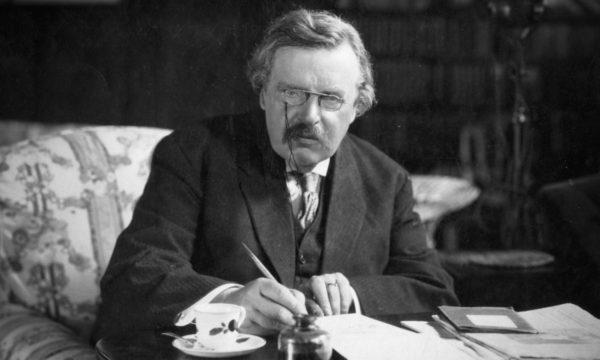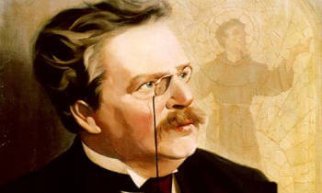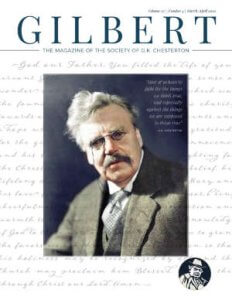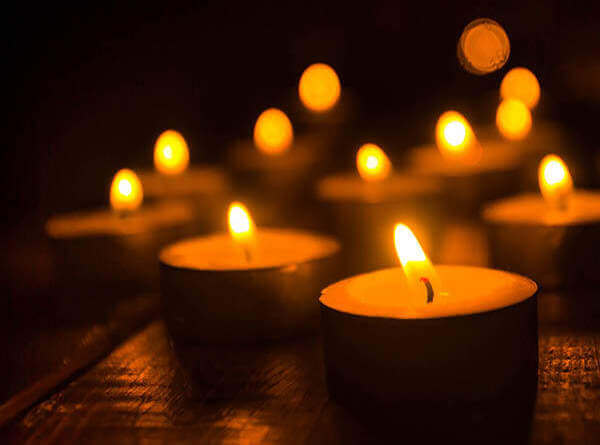Certain magazines have symposiums (I will call them ‘symposia’ if I am allowed to call the two separate South Kensington collections ‘musea’) in which persons are asked to name ‘Books that have Influenced Me’, on the lines of ‘Hymns that have Helped Me’. It is not a very realistic process as a rule, for our minds are mostly a vast uncatalogued library; and for a man to be photographed with one of the books in his hand generally means at best that he has chosen at random, and at worst that he is posing for effect. But in a certain rather special sense I for one can really testify to a book that has made a difference to my whole existence, which helped me to see things in a certain way from the start; a vision of things which even so real a revolution as a change of religious allegiance has substantially only crowned and confirmed. Of all the stories I have read, including even all the novels of the same novelist, it remains the most real, the most realistic, in the exact sense of the phrase the most like life. It is called The Princess and the Goblin, and is by George MacDonald, the man who is the subject of this book.
When I say it is like life, what I mean is this. It describes a little princess living in a castle in the mountains which is perpetually undermined, so to speak, by subterranean demons who sometimes come up through the cellars. She climbs up the castle stairways to the nursery or the other rooms; but now and again the stairs do not lead to the usual landings, but to a new room she has never seen before, and cannot generally find again. Here a good great-grandmother, who is a sort of fairy godmother, is perpetually spinning and speaking words of understanding and encouragement. When I read it as a child, I felt that the whole thing was happening inside a real human house, not essentially unlike the house I was living in, which also had staircases and rooms and cellars. This is where the fairy-tale differed from many other fairy-tales; above all, this is where the philosophy differed from many other philosophies. I have always felt a certain insufficiency about the ideal of Progress, even of the best sort which is a Pilgrim’s Progress. It hardly suggests how near both the best and the worst things are to us from the first; even perhaps especially at the first. And though like every other sane person I value and revere the ordinary fairy-tale of the miller’s third son who set out to seek his fortune (a form which MacDonald himself followed in the sequel called The Princess and Curdie), the very suggestion of travelling to a far-off fairyland, which is the soul of it, prevents it from achieving this particular purpose of making all the ordinary staircases and doors and windows into magical things.
Dr. Greville MacDonald, in his intensely interesting memoir of his father which follows, has I think mentioned somewhere his sense of the strange symbolism of stairs. Another recurrent image in his romances was a great white horse; the father of the princess had one, and there was another in The Back of the North Wind. To this day I can never see a big white horse in the street without a sudden sense of indescribable things. But for the moment I am speaking of what may emphatically be called the presence of household gods – and household goblins. And the picture of life in this parable is not only truer than the image of a journey like that of the Pilgrim’s Progress, it is even truer than the mere image of a siege like that of The Holy War. There is – something not only imaginative but intimately true about the idea of the goblins being below the house and capable of besieging it from the cellars When the evil things besieging us do appear, they do not appear outside but inside. Anyhow, that simple image of a house that is our home, that is rightly loved as our home, but of which we hardly know the best or the worst, and must always wait for the one and watch against the other, has always remained in my mind as something singularly solid and unanswerable; and was more corroborated than corrected when I came to give a more definite name to the lady watching over us from the turret, and perhaps to take a more practical view of the goblins under the floor. Since I first read that story some five alternative philosophies of the universe have come to our colleges out of Germany, blowing through the world like the east wind. But for me that castle is still standing in the mountains and the light in its tower is not put out.
All George MacDonald’s other stories, interesting and suggestive in their several ways, seem to be illustrations and even disguises of that one I say disguises, for this is the very important difference between his sort of mystery and mere allegory. The commonplace allegory takes what it regards as the commonplaces or conventions necessary to ordinary men and women, and tries to make them pleasant or picturesque by dressing them up as princesses or goblins or good fairies. But George MacDonald did really believe that people were princesses and goblins and good fairies, and he dressed them up as ordinary men and women. The fairy-tale was the inside of the ordinary story and not the outside. One result of this is that all the inanimate objects that are the stage properties of the story retain that nameless glamour which they have in a literal fairy-tale. The staircase in Robert Falconer is as much of a magic ladder as the staircase in the Princess and the Goblin; and when the boys are making the boat and the girl is reciting verses to them, in Alec Forbes, and some old gentleman says playfully that it will rise to song like a magic Scandinavian ship, it always seemed to me as if he were describing the reality, apart from the appearance, of the incident. The novels as novels are uneven, but as fairy-tales they are extraordinarily consistent. He never for a moment loses his own inner thread that runs through the patchwork, and it is the thread that the fairy great-grandmother put into the hands of Curdie to guide him out of the mazes of the goblins.
The originality of George MacDonald has also a historical significance, which perhaps can best be estimated by comparing him with his great countryman Carlyle. It is a measure of the very real power and even popularity of Puritanism in Scotland that Carlyle never lost the Puritan mood even when he lost the whole of the Puritan theology. If an escape from the bias of environment be the test of originality, Carlyle never completely escaped, and George MacDonald did. He evolved out of his own mystical meditations a complete alternative theology leading to a completely contrary mood. And in those mystical meditations he learned secrets far beyond the mere extension of Puritan indignation to ethics and politics. For in the real genius of Carlyle there was a touch of the bully, and wherever there is an element of bullying there is an element of platitude, of reiteration and repeated orders. Carlyle could never have said anything so subtle and simple as MacDonald’s saying that God is easy to please and hard to satisfy. Carlyle was too obviously occupied with insisting that God was hard to satisfy; just as some optimists are doubtless too much occupied with insisting that He is easy to please. In other words, MacDonald had made for himself a sort of spiritual environment, a space and transparency of mystical light, which was quite exceptional in his national and denominational environment. He said things that were like the Cavalier mystics, like the Catholic saints, sometimes perhaps like the Platonists or the Swedenborgians, but not in the least like the Calvinists, even as Calvinism remained in a man like Carlyle. And when he comes to be more carefully studied as a mystic, as I think he will be when people discover the possibility of collecting jewels scattered in a rather irregular setting, it will be found, I fancy, that he stands for a rather important turning-point in the history of Christendom, as representing the particular Christian nation of the Scots. As Protestants speak of the morning stars of the Reformation, we may be allowed to note such names here and there as morning stars of the Reunion.
The spiritual colour of Scotland, like the local colour of so many Scottish moors, is a purple that in some lights can look like grey. The national character is in reality intensely romantic and passionate indeed, excessively and dangerously romantic and passionate. Its emotional torrent has only too often been turned towards revenge, or lust, or cruelty, or witchcraft. There is no drunkenness like Scotch drunkenness; it has in it the ancient shriek and the wild shrillness of the Maenads on the mountains. And of course it is equally true on the good side, as in the great literature of the nation. Stopford Brooke and other critics have truly pointed out that a vivid sense of colour appears in the medieval Scottish poets before it really appears in any English poets. And it is absurd to be talking of the hard and shrewd sobriety of a national type that has made itself best known throughout the modern world by the prosaic literalism of Treasure Island and the humdrum realism of Peter Pan. Nevertheless, by a queer historical accident this vivid and coloured people have been forced to ‘wear their blacks’ in a sort of endless funeral on an eternal Sabbath. In most plays and pictures, however, in which they are represented as wearing their blacks, some instinct makes the actor or the artist see that they fit very badly. And so they do.
The passionate and poetical Scots ought obviously, like the passionate and poetical Italians to have had a religion which competed with the beauty and vividness of the passions, which did not let the devil have all the bright colours, which fought glory with glory and flame with flame. It should have balanced Leonardo with St. Francis; no young and lively person really thinks he can be balanced with John Knox. The consequence was that this power in Scottish letters, especially in the day (or night) of complete Calvinistic orthodoxy, was weakened and wasted in a hundred ways. In Burns it was driven out of its due course like a madness; in Scott it was only tolerated as a memory. Scott could only be a medievalist by becoming what he would call an antiquary, or what we should call an aesthete. He had to pretend his love was dead, that he might be allowed to love her. As Nicodemus came to Jesus by night, [See John 3:1] the aesthete only comes to church by moonlight.
Now, among the many men of genius Scotland produced in the nineteenth century, there was only one so original as to go back to this origin. There was only one who really represented what Scottish religion should have been, if it had continued the colour of the Scottish medieval poetry. In his particular type of literary work he did indeed realize the apparent paradox of a St. Francis of Aberdeen, seeing the same sort of halo round every flower and bird. It is not the same thing as any poet’s appreciation of the beauty of the flower or bird. A heathen can feel that and remain heathen, or in other words remain sad. It is a certain special sense of significance, which the tradition that most values it calls sacramental. To have got back to it, or forward to it, at one bound of boyhood, out of the black Sabbath of a Calvinist town, was a miracle of imagination.
In noting that he may well have this place in history in the sense of religious and of national history, I make no attempt here to fix his place in literature. He is in any case one of the kind that it is most difficult to fix. He wrote nothing empty; but he wrote much that is rather too full, and of which the appreciation depends rather on a sympathy with the substance than on the first sight of the form. As a matter of fact, the mystics have not often been men of letters in the finished and almost professional sense. A thoughtful man will now find more to think about in Vaughan or Crashaw than in Milton, but he will also find more to criticize; and nobody need deny that in the ordinary sense a casual reader may wish there was less of Blake and more of Keats. But even this allowance must not be exaggerated; and it is in exactly the same sense in which we pity a man who has missed the whole of Keats or Milton, that we can feel compassion for the critic who has not walked in the forest of Phantastes or made the acquaintance of Mr. Cupples in the adventures of Alec Forbes.





